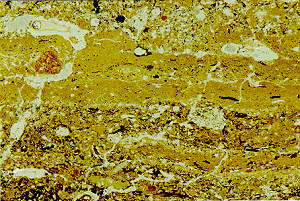Microscopic and Chemical Analyses of Uses of Space
by Wendy MatthewsExciting new information on domestic and ritual activities at Çatalhöyük is being discovered by microscopic and chemical analysis of floor plasters and occupation deposits.
Changes in activities both across floors and through time can be traced by study of variation in the types of floors laid in different areas, the impact of activities on surfaces, and the nature of deposits accumulating on floors from different activities. We are also studying the nature of alterations to deposits since they were buried in the Neolithic, and ancient land surfaces around the settlement in collaboration with KOPAL palaeoecologists.
The techniques which we are using to study floor plasters, occupation deposits and architectural materials include microscopic study of resin impregnated sequences of deposits in large glass thin sections, microscopic study of plant silica micro-fossils and organic and inorganic chemical analyses.
Results include identification of changes in activity areas in buildings within the space of one to two metres. Some similarities are emerging in buildings excavated across the site. Lenses of wood, grass and dung fuel accumulated close to ovens and hearths. Thick layers of constructional packing were laid in areas and bins used for food storage. Multiple layers of white plaster were laid on top of platforms that were used for sitting and burial. These platform surfaces are remarkably clean, even under the microscope, and were probably covered with mats, textiles or animal skins. We are also detecting traces of red ochre associated with some burials and platform surfaces. An unusual reddish floor was uncovered in a narrow room with white plastered basins in Building 5, Space 155. These similarities in contextual variation in surface features, treatment and residues suggest the existence of shared sociocultural behaviour, concepts and spatial conventions, which may be more fully understood after detailed study of thin sections and other multidisciplinary data.
On the collapsed roof in Building 3 in the BACH area we have identified water-laid deposits from rainstorms (Figure 17), and are looking for changes in activities on roofs during different seasons and on different areas of the roof. We are also studying the microstratigraphy of deposits thrown into open areas and some abandoned buildings. We have been able to identify the discarded remains of single activities such as wood-working, from study of thin layers of shaved wood fragments and obsidian chips, and food preparation and cooking from deposits originally swept up from floors.
